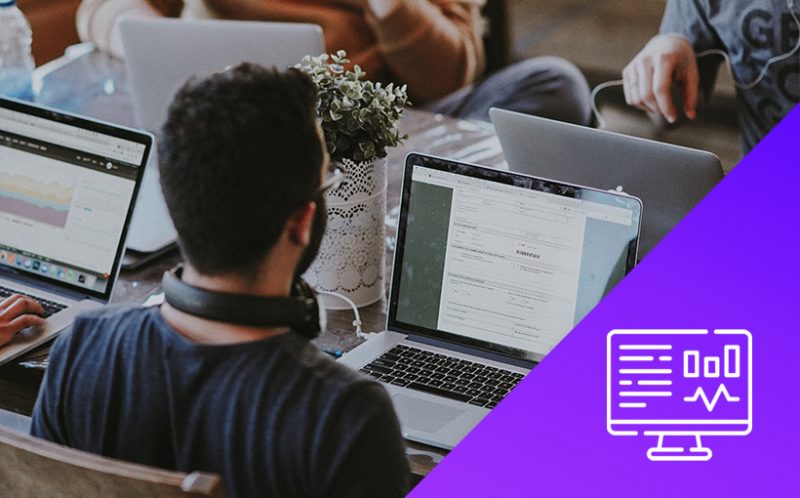A complex product that is not always clear to consumers, high prices, off-scale competition — it is not easy to advance in the IT services market even with large budgets. “Generalist” marketers often do not understand the specifics of the niche and use traditional promotion models that do not lead to the expected results. Clients spend huge amounts, but do not get the desired effect.
Our new case is an example of integrated marketing, which can be used to promote an IT company’s website in a relatively short time without serious investments, increasing traffic by several dozen times.
How to advertise an IT company: an adapted marketing strategy for the IT niche
Client: Russian company, business line — IT-services in the B2B segment, consulting.
Problems: there is no audience, the site does not convert applications, there is no clear marketing strategy.
The client began to engage in promotion back in 2015. He attracted mainly commercial traffic, tried to use Internet marketing, but this practically did not affect the number of customers and profits. The site developed slowly, the audience was not recruited. Requests came, but they were very few. In total, over 2 years the resource was visited by a little more than 30 thousand users. In 2017, a client approached us with the task of bringing traffic to a higher level, increasing the number of hits and conversions.
Working, like our client, in the field of information technology, we had a completely different development experience. We introduced various mechanics and innovations, experimented, analyzed the results. Having spent from 6 to 8 million rubles on testing different tools and bundles over several years, we developed our own strategy for promoting the company, thanks to which, in a short time, we increased traffic to our IT and marketing blog by almost 30 (!) times. Gradually, other metrics also grew: conversion, applications, sales. We have proposed this strategy to our client.
Market research
We started with global market research. Usually, the first stage of SEO optimization involves the collection of semantics, and competitors are analyzed based on it. This is useful when the topic is unfamiliar and you need to collect the maximum number of key phrases. But the classical technique has 2 drawbacks:
Along with “juicy” keywords that show great interest in the topic, a lot of junk requests are collected, which take a lot of time to filter out.
And most importantly, such semantics does not give an objective picture. Collecting the semantic core, cleaning and clustering is a long process, and before deep processing of semantics it is impossible to predict whether there is real demand, whether it will bring commercial traffic.
Since we specialize in information technology and know the specifics of the niche from the inside, we took a different path in working on this case and immediately took on competitors:
- compiled a list of 100 large IT companies in the segment;
- made a selection of traffic tops in each sub-niche;
- studied the subject of sites, identified the most popular headings suitable for our client;
- in each of the segments, materials were selected that give high traffic, that is, they meet the needs that are really in demand on the market.
Content marketing and semantics for infotraffic
Based on the selected materials, we began to form a content plan — first by headings, then by future publications.
Due to high competition, commercial traffic is very expensive for an IT company, so when promoting both in Russia and in the West, you should not rely solely on advertising. We decided to focus on information traffic. It captures a wider audience, the competition for it is lower, and with the introduction of certain mechanics, you can work with it more efficiently. Therefore, after the formation of the content plan for the headings, we returned to the stage of semantic analysis. For each material, from 400 to 2,000 requests were analyzed, from which 12 to 20 (sometimes more) were selected to be included in the texts.
The work is very time-consuming, but it fully justified itself — in the future it gave the customer a good share of traffic.
All content for the blog was divided into 3 main areas:
- Instructions, guides.
- Informational articles of a general nature (+ supporting articles with requests from a near-thematic environment to get search positions).
- Case packing.
Used mechanics of IT company promotion
We used a whole set of mechanics that were tested on our project and repeatedly used in customer projects. The most effective is the complex application of these methods.
How to promote an IT company in Yandex and Google with the help of additional in-depth research
Deep immersion in the subject provides an advantage in marketing strategies. The methodology changes depending on the tasks at hand, but it never fails to collect primary information.
Selection of promising requests
The goals of deep research may differ. For example, they can be used to evaluate the prospects of search queries — how well they sell. Once we needed to process about 650 customer requests for 20+ sites. As a result, we have isolated the strict body of the search query and identified its main tails. Based on this sample, we compiled an SEO matrix:
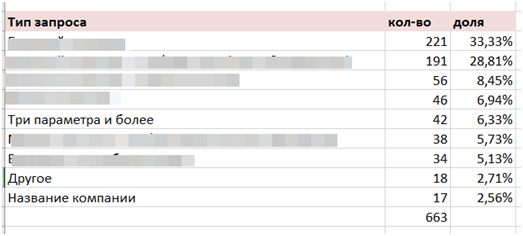
The output data clearly demonstrates the effectiveness of search queries: keywords containing 3 or more tracked parameters are found among applications in 5-7% of cases, and the company name — in only 2-3%. The study was conducted for a non-branded product — for popular brands, the ratio will be different.
Similarly, you can estimate the number of words in effective queries:
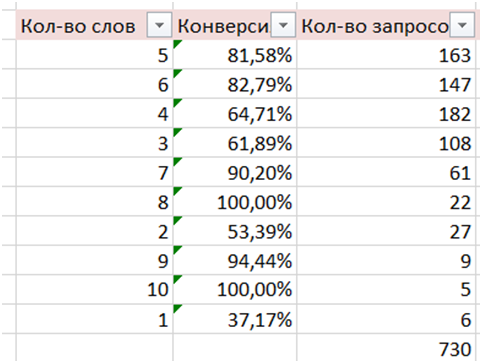
We applied the same mechanics in this case. An in-depth study made for the customer made it possible to get a clear idea of which queries should be worked on, optimizing advertisements and web pages for them, and which ones should be excluded, since they will not bring any benefit.
Expert materials
Another example of in-depth research is the preparation of expert publications. It was decided to place expert materials on the four most popular areas in the IT niche on the customer’s blog. For example, one of the studies was devoted to IP-telephony.
In order for the content to be useful to visitors and drive more traffic, we had to dive deep into each of the topics. For this we:
- collected information on top vendors, services and products related to the chosen topic;
- managers of all selected companies were interviewed under the guise of a client/partner;
- made an analysis of the obtained data.
Questionnaires for interviews included 20-30 questions, sorted by the same number of parameters. The lists included from 50 to 200 studied objects. It took 60 to 100 hours to prepare each of the materials.
Creating an expert article is painstaking, complex, labor-intensive and expensive work. Therefore, there were few such materials, but they gave a very good result.
- In terms of text factors, the site pages have taken stable positions in Google and Yandex.
- Leading companies in the niche to which the article was devoted began to contact our client with a request for placement.
The publication of expert material is beneficial in the long run, as it gradually leads to an increase in traffic and an increase in conversion. However, one must understand that the effect will not be endless and the material will have to be updated regularly.
Link Building
The next step was to run the site through different content islands. We have gradually deployed to approximately 100 sites:
- in Internet directories;
- on industry and news portals;
- on the forums;
- in «Yandex.Q», other services of questions and answers.
In addition to the classic «gentleman’s kit», we used non-obvious methods of link building, up to posting in blog comments and getting backlinks from charitable foundations web resources.
Link building is one of those tricks that can give you a good link mass. Requires a lot of resources for implementation, but allows you to reach high positions. Soon, for many niche queries, we brought the client’s blog to the top of the search. In particular, at the request of “system integrator”, even the websites of companies with billions of dollars were overtaken.
Free link problems
- Low survival: 5–10% at an interval of six months to a year. Some of the links will not be placed or will be deleted by administrators, others will not be indexed. Some sites will cease to exist altogether — according to statistics, in three years, out of 300 free donors, approximately 100 remain.
- Most donor sites do not initially pass the test on the simplest SEO metrics. In practice, out of the entire sample, only about 1% (!) of donors will meet the requirements, place a link and last at least a year and a half.
Free links are not ideal, and their freeness is conditional. The cost of placing each such link, taking into account the manager’s time spent on obtaining it, averages 2,000 rubles.
Link exchanges
To make link building more productive, the practice of spreading backlinks through various exchanges is widely used in RuNet. Google has a very negative attitude towards artificial link building, so in the US and Europe it began to fight with such services back in the mid-2000s. But in Russia it was not possible to cope with them — they firmly settled here and, with varying success, are trying to export their services abroad.
SEO links are well indexed, but search engines often exclude them from ranking. So, «Yandex» filters up to 98% of such links.
In Runet, there are many sites that help build up the reference mass. The most famous of them:
- Miralinks — is positioned as an article exchange and offers platforms for posting materials, so the appearance of a backlink looks natural for search engines;
- Sape — provides both eternal and not very practical rental links, however, for non-format projects this is sometimes the only solution.
It will not work now to reach the top solely due to link factors, but in combination with other tools, a careful build-up of external links will be useful for promotion.
Lease or permanent: which is better?
The cost of rental links ranges from a few rubles to several thousand per month. Once you start working with links, you can’t stop, so every month you have to pay more and more, maintaining the old link mass and expanding it with new ones.
With perpetual links, it’s a little easier: you only need to pay for them once. However, «eternity» is relative — the link exists as long as the donor is alive, but the life span of a paid donor is much longer compared to a free one.
We offered the customer to purchase 150–200 links, building up the link base gradually, over one or two years, at a rate of 10–20 links per month.
Here’s what systematic link building looks like:

The number of identified links for each project is individual and to some extent depends on the competitive environment. For example, if a company were forced to compete in SERPs with access to a consumer market, even when considering the range of services and services, we would have to redirect at least 6,000–8,000 backlinks.
How to promote an IT company through outreach
Our customer was interested in promoting his IT project not only in Russia, but also in the foreign market. And since the traditional strategy of link building by buying leased and permanent links does not work well in the West, we decided to use the outreach method.
Outreach is a direction of crowd marketing, which involves the promotion of a web resource by placing backlinks by personal agreement with bloggers and site owners. The method allows you to improve organic ranking, expand your audience, strengthen user trust, and increase brand awareness.
The technique is very resource-intensive both in terms of communication (even with advanced negotiation skills, no more than 3-4% of recipients respond), and in terms of preparing content intended for placement on third-party sites.
Is it worth it? I guess, yes. The advantage of the method is that really authoritative thematic sites with high traffic begin to link to the site. Potentially, such links can also bring direct targeted traffic.
Outreach is not cheap, primarily because it implies a very high quality of content. Therefore, it is possible to prepare and place no more than 3–5 materials per month, and even such a small amount completely takes up all the working time of the outreach specialist. The cost of an expert article reaches 9,000–10,000 (for 2022) rubles, and this is not the limit.
Site fees vary. Sometimes you can stay for free, but this is rather an exception. Depending on the authority and attendance of the resource, one link is estimated from 200 to 500,000 rubles.
Thanks to complex link building, we managed to increase the link weight of the customer’s website and get additional targeted traffic. Since getting backlinks is one of those processes that should not stop, work in this direction continues.
LSI copywriting
In addition to expert and classic SEO-optimized materials, we prepared articles for the blog of an IT company created using LSI copywriting.
LSI copywriting (from the English latent semantic indexing — latent semantic indexing) is a text optimization technology, when not the accuracy of key queries comes to the fore, but words and phrases that are closest in meaning to the subject of the article.
In texts based on the principles of LSI, many obvious and non-obvious relationships are created, which helps the search engine to better understand the content, match it to the search query and select the most relevant pages. The main task of the optimizer is not to saturate the content with semantics, but to create a text that fully reveals the declared topic.
Evergreen content
Speaking of attracting traffic and increasing the ranking of a web resource in search engines, one should not forget about such a content marketing method as creating evergreen content.
Evergreen content — materials that do not lose relevance over time (or lose only slightly). In the topic under consideration, such materials will include, for example, articles for requests: “how to promote an IT company”, “examples of promotion in social networks”, “Internet marketing for an IT project”, “case for promoting an IT company in Russia » etc.
In the niche of the customer, these are various instructions, manuals, analytical articles, case studies, etc. It was mentioned above that we included such materials in the content strategy.
Posting long-running content is beneficial for at least two reasons:
- this eliminates bursts of activity — attendance does not depend on new publications and remains within the same range;
- behavioral factors are improving, the natural link mass is growing — evergreen articles are read, commented, shared links to them in social networks and other resources.
Technical optimization
It is necessary to constantly monitor the loading speed, the functionality of the modules, the absence of broken links and unnecessary redirects, and other site parameters. Technical optimization is needed not only to reach certain positions in the search, but also to stay on them.
From the point of view of technical optimization, the client’s site was configured not quite correctly and required modifications. Having worked hard on it at the end of 2017, already in January-February 2018, we received a significant increase in traffic, breaking the bar of 1,000 visitors weekly.

By itself, technical optimization does not give strong growth, but it improves performance, speed, and other important indicators and becomes a kind of entrance ticket to the top 10 search engines.
The minimum score we were aiming for was 70 for desktop devices and 40 for mobile devices. Now we need to make sure that we always stay in the green or yellow zone:
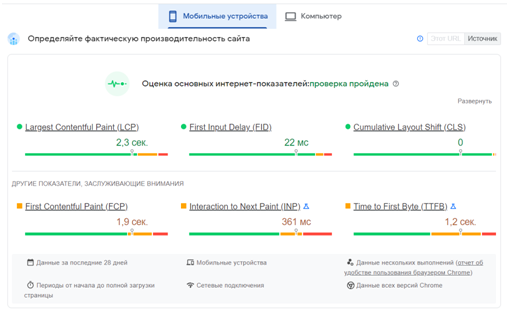
In a highly competitive environment, being in the green zone creates a slight advantage, and if the site is already in the top 10, then, for example, page loading speed does not play a big role. In general, you need to focus on the mobile index, which Google pays special attention to.
Another important indicator of the quality of technical optimization is the safety of the site for visitors. Directly, it affects the ranking insignificantly (in the extreme case, a resource in the top 10 will be marked as potentially dangerous), but it has an indirect effect on the business as a whole.
We assessed the security of the IT provider site using standard tools — Google Search Console, Yandex. Webmaster», regular hosting tools:
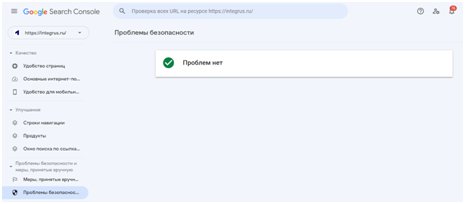
We checked the quality of both the desktop and mobile versions of the site:
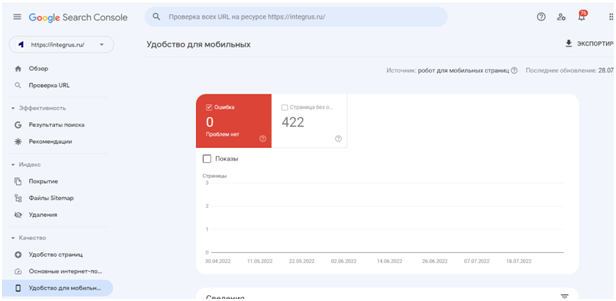
Technical optimization tools also include indexing settings:
- robots.txt — a file where the main parameters are set, according to which the site should be indexed by search bots;
- robots meta tags — a special code that allows you to manage indexing and display settings in search results at the page level;
- Last Modified Since, a vital parameter for online stores, portals and other large online projects;
- sitemap.xml is a site map that conveys the actual structure of the web resource to the search engine and helps to navigate among the many folders and files.
We set all this up as needed, and also changed the regional affiliation of the online platform in Yandex.
Ignoring indexing management issues can bring unpleasant surprises as early as 2-3 months after the start of work.
How to promote an IT company in social networks: a set of retargeting base
As soon as the active process of working on the case began, we placed social media pixels (Facebook, VKontakte, MyTarget) on the IT company website. Over time, this helped to gain a large base for retargeting advertising campaigns and work with potential customers. Today, the audience of each of the bases is from 100,000 to 150,000 thousand, which greatly facilitates promotion to both Russian and foreign audiences.
A large base allows you to conduct various PR campaigns. For example, now many enterprises are returning their resources from the West back to Russia. Accordingly, we can select an audience segment that was interested in the topic of migration to Russian servers or the topic of corporate mail, and show ads for this segment.
There were about 200 segments that we did based on retargeting. We identified 30 main ones, linked them with quizzes and landing pages, setting up ads on Facebook, Yandex.Direct, Google Ads for these bundles.
Transferring an audience from a retargeting database to a specific offer is one of the simple mechanics that we use ourselves and in client projects. It works like this:
- We select users who read the blog materials with high engagement, but for some reason did not leave a request.
- We transfer this audience to a specific offer and close it for a consultation or simply show branded advertising for reach.
By the way, a simple advertising for brand reach had a very interesting effect: old partners and clients to whom the company had already provided services began to contact our client.
Behavioral factors
A very important part of the job. It is necessary to analyze behavioral factors (PF) constantly. To do this, we used special analytical tools, in particular Yandex.Metrika and Google Analytics.
Taken separately, analytics is not of particular interest — what matters is what conclusions it leads to. For example, when choosing a targeting strategy, gender, age, and audience interests matter.
Examples of working with analytics
The graph below shows that the highest bounce rate is in the audience under 24 years old, and the lowest in people over 35 years old.
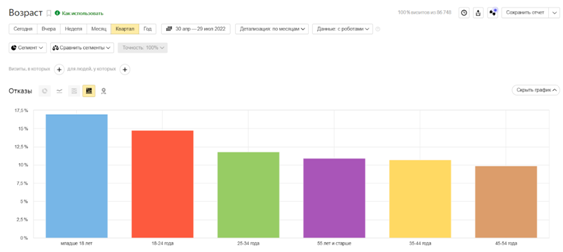
The second graph shows that about 25% of visitors are young people under 24 years old.
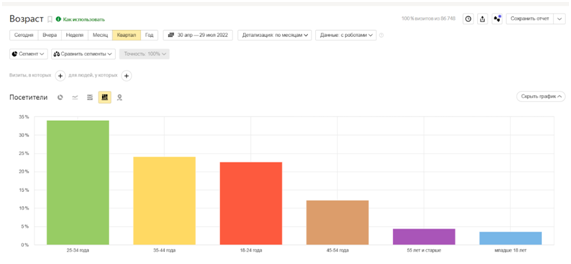
How can this be interpreted? Despite the fact that the client’s blog is focused on IT services, there are also student requests, that is, non-targeted requests. So, when creating a content plan for future publications, we need to take this into account. If the audience consisted of young people under 24 by 50%, and bounces rose above 25%, we would need to change the content completely.
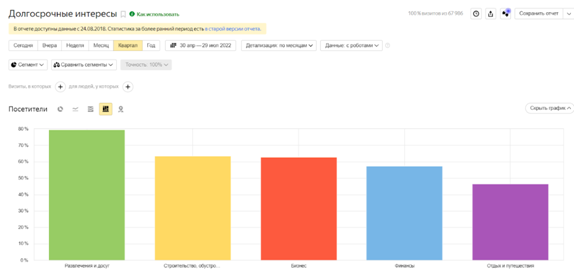
Another example. The graph above shows that 80% of the audience is interested in the topic of entertainment, about 64% in repairs, and 46% in leisure and tourism. The obvious conclusion that can be drawn is that we are working with the wrong audience. In fact, these are “universal” topics that are of interest to almost all Internet users. Therefore, they are not informative and we can safely discard them.
What other information can be obtained from analytics
From the analytics data, you can also find out where users get to the site from — the main entry points:
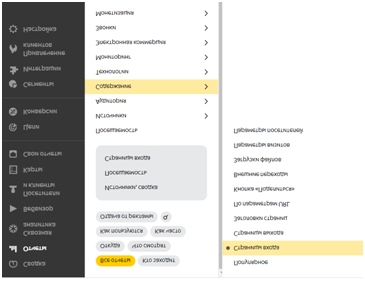
This information helps to determine the main traffic pages. And to find out how users behave on specific pages, we drill down and look at metrics such as time on page, bounces, browsing depth. We evaluate the most interesting pages at the webvisor level.
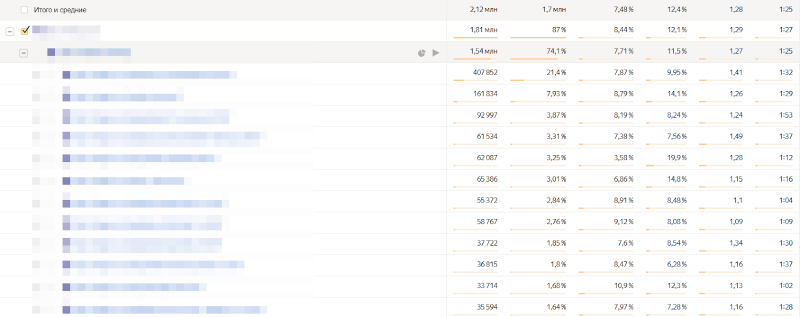
Based on the analysis, we draw conclusions and make appropriate adjustments to the site. Adjustment options will differ, depending on the indicators:
- on pages where the bounce rate is slightly better than the overall site, and other metrics are in the normal range, you may need to increase the amount of content and add internal links to other sections.
- at low rates, the content will have to be completely reworked.
Analytical tools allow you to make a selection according to the required metrics and get a list of pages, the improvement of which will potentially improve internal PFs.
Search engines actively monitor user behavior. Improving the PF reduces the percentage of return to search results for query refinement, which has a positive effect on ranking.
Bundles
The mechanics used on the website of the IT company helped to increase traffic several times. All that was left was to convert it correctly. We decided to include proven bundles that performed well in our project:
retargeting database + quiz marketing + landing pages for consulting
It was necessary to adapt them to the customer and identify the segments that bring the most profitable applications. We made measurements, mass retargeting, segmentation, launched advertising, began to reload traffic from different networks to these bundles. We looked at how much the application costs for each segment. We focused on volumes: if there were no applications at all, but everything was with the technical settings and the offer, such segments were turned off. As a result, 2 of the most cost-effective bids were selected from 30 selected segments.
Subscription base
We automated the collection of contacts for the database of email addresses and the database in Telegram. We turned on retargeting, made subscription pages. The email database increases by about 30 new subscribers every month, Telegram collects from 10 to 20. All this is fully automatic and with zero investment.
Now we are finalizing the mechanics, in particular, we are going to add a target to Telegram, which should increase the speed of recruiting a subscription base by 20–30%.
Channel in Yandex.Zen
At the same time, they started running a thematic Zen channel, from which some of the traffic also comes — at the peak, 500,000–600,000 coverage is obtained.
In addition to «drive» visitors to the site, «Yandex.Zen» can help in the formation of a retargeting base and increase brand awareness — the site has the appropriate advertising technologies.
The blog platform is good as an addition to other Internet marketing tools, but we would not recommend relying on it too much — Yandex.Zen has two serious limitations:
- The blog does not belong to the author. At any time, the administration can block the channel or individual articles / posts, limit advertising traffic, make technical adjustments or change the terms of use. The figure below is an example of such a situation. They worked on the traffic for several months, but one day Yandex simply changed the addresses of the Zen channel without setting redirects (after three months of correspondence with technical support, redirects were still installed, but incorrect — 302 instead of 301). As a result, traffic decreased several times.
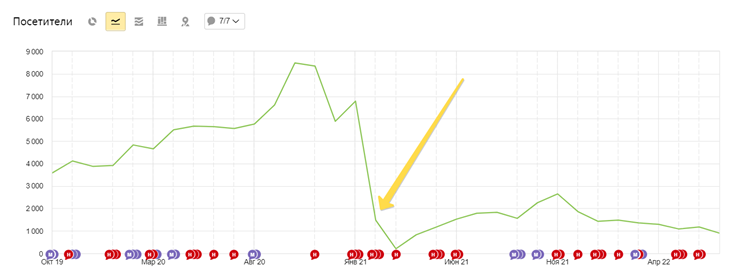
- Zen is more suitable for promoting B2C projects, as entertainment traffic dominates on the site.
Chat Automation
When there is a lot of traffic, we always recommend customers to connect automation. As numerous tests have shown, it works for all major languages and gives good results in any niche.
For this case, we set up auto-invites in the online consultant. Divided the audience into segments. All materials on the client site (at that time there were about 500–600 of them) were divided into topics and pages, combined into categories. For each category, a simple open-ended question was created to help qualify users. There were about 80 such questions.
They wrote first — if the bot noted that a person was on the page for more than 60 seconds, that is, he had an obvious interest in the material, a question prepared in advance for a specific audience was sent to the chat. For example: a visitor reads an article about 1C — we ask how many employees he needs to automate CRM for. Depending on the answer, we arrange a personal meeting, invite you to Zoom, or transfer the application for processing in standard mode.
Auto-invites facilitate the process of qualifying applications, cutting off unpromising ones and giving an understanding of how to work with potential clients further. In addition, they convert well and bring in sales.
We use auto-invites on the online platforms of many customers, sometimes this leads to large deals with top service consumers.
Website personalization
Another mandatory component of setting up a web resource. The number of incoming calls largely depends on how the company initially positions itself in the market. For example, if the site lists only a local phone number, you should not count on high traffic and customers from other regions.
Our client was targeting not only Russian, but also foreign audiences. Therefore, we technically set up the site to receive traffic from different regions of the world: we made the appropriate optimizations, recommended buying a set of regional numbers, enabled geo-parameters, registered in the necessary directories, enabled the functionality for replacing contacts, etc. This gave a big increase in traffic.
When setting up site personalization, a simple rule applies: where the demand zone is, those regional numbers should be used.
The simplest thing we can recommend to companies that are moving to several regions within the country is to get a phone number with the code 8-800. When a visitor sees such a number, he immediately understands that the company works for the whole of Russia. Just placing a free phone number 8-800 in the header can increase the conversion by 2 times.
If we are talking about foreign segments, we always advise you to buy and indicate in contacts the phone numbers of the country into the language of which the multilingual site is being translated. This gives very cool results.
Integrations
We set up a set of integrations to automate part of the processes and the company could manage with a small number of managers:
- Roistat (including call tracking);
- CRM Bitrix24;
- Albato;
- WhatsApp and Telegram (with the ability to write first).
Thanks to integrations, all incoming emails, online chats and instant messengers are collected directly in CRM. Now potential customers are not lost, and one specialist can process up to 10-15 complex applications daily.
In the B2C segment and more simple topics compared to information technology, with properly configured integrations, the manager can handle up to 200 (and sometimes up to 500) calls per day.
Integrations not only pull data from different services and allow you to communicate in one window mode, but also make it possible to write first in WhatsApp and Telegram. And this functionality greatly simplifies the interaction with potential customers.
We also implemented multi-channel analytics on the customer’s website and enabled dynamic email tracking, which changes the email address depending on the source of the referral.
Results
During the work on the project, we raised traffic by about 45 times. If in 2015–2017 32,000 visitors visited the site (statistics for 2 years), then by 2020 we managed to reach 30,000–50,000 visits per month.
And by the end of 2020, attendance has grown to 50,000-60,000 uniques monthly.
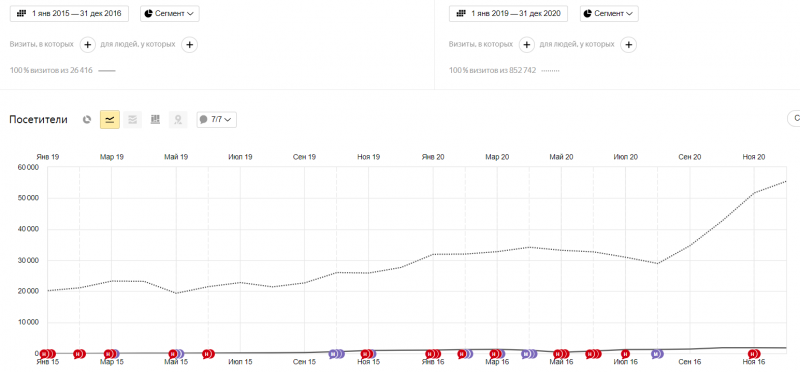
We have also collected an extensive retargeting database (about 350,000 people in total), which can be monetized many times in the future.
The number of applications from the site increased by 1000%, conversion to sales — by 32%.
Since 2016, we have been working in the field of information technology and digital marketing. Understanding the specifics of a niche helps us achieve better results when promoting IT companies compared to marketing agencies without experience in this area.
Click on the Whatsapp button to get the checklist
«Marketing Plan for an IT company. 15 Ways to Promote»
+ access to the lead generation system for IT
Get the checklist
«Marketing Plan for an IT company. 15 Ways to Promote»
Click below
